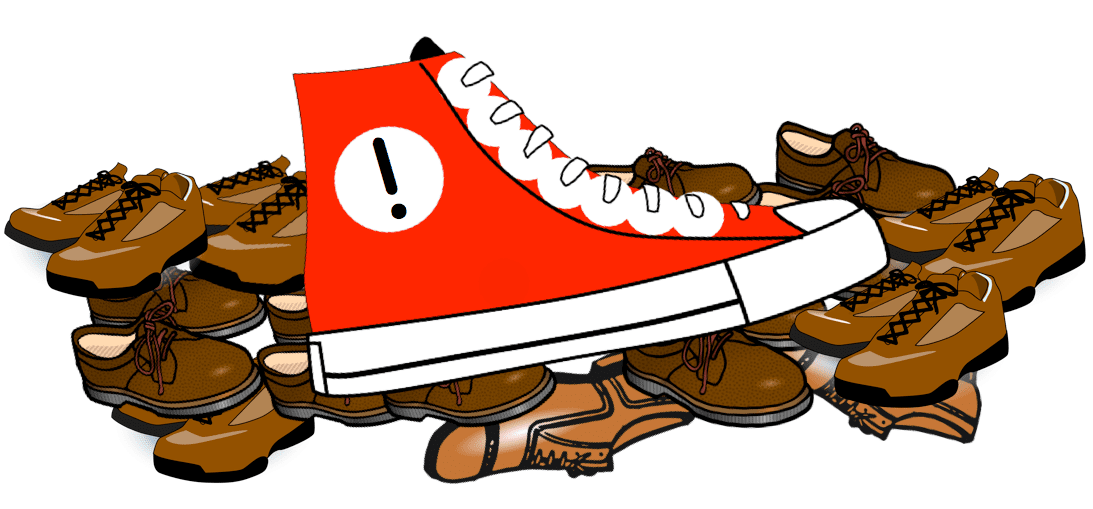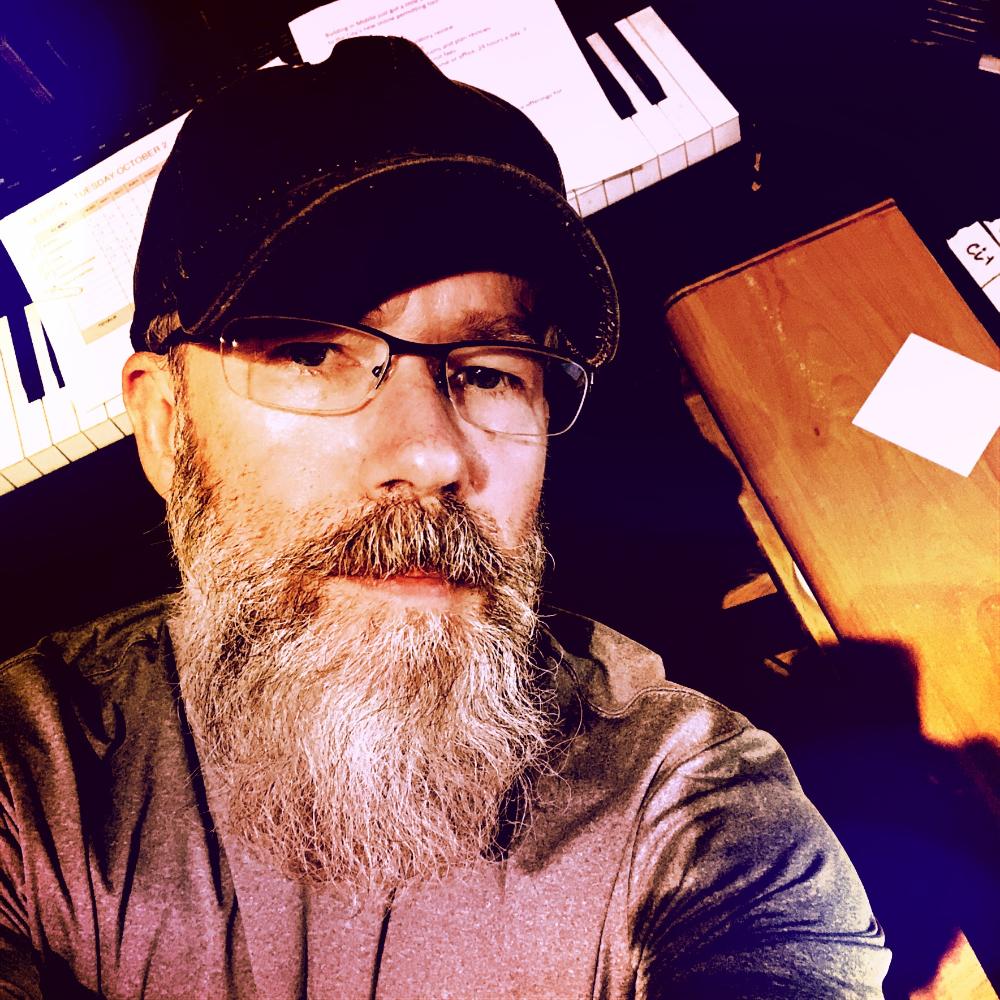Radio imaging voices, liners and sweepers are a lot like brown shoes. Why? ‘Cause everywhere you look, you see brown shoes that look very, very similar. And everywhere you listen, you hear radio imaging that sounds very, very similar.
Brown shoes are "safe", and a lot of radio imaging sounds like whoever wrote, produced or voiced it wanted to play it safe. Problem is, if you limit yourself to “I gotta have brown shoes”, it's hard to differentiate yourself. Sure, you might be able to see the subtle difference in the shades of brown, but other's probably won't notice any difference at all. Now, if your goal is to blend in, then by all means, spend all weekend choosing between varying shades of brown. Or, in the case of radio imaging, choosing between varying shades of “deep male” voices, and slightly different lasers, zaps and hits. But if you want to be memorable, and stand out, you need to think outside the deep brown box.
I produce radio imaging, voice over and sound design for a wide variety of end users. But whether I’m dealing with a radio program director, an ad agency creative team, or directly with a client, the flow often goes like this:
Client: “We want something outside the box!”
Me: Produces something outside the box
Client: “Um… it’s a little out there for us…”
Me: Tones it down a bit
Client: “Um... so listen to this thing we like that someone else has done”
The above is not always the case, but it’s the case all too often. As in: it happens and it should not happen––ever. I mean, what's the point of your station's imaging imitating someone else's sound?
Over time though, I'v learned to propose this thought: Are you afraid of taking a risk? Because the biggest risk, it seems to me, is sounding like everyone else.
It’s a very important point, and one those of us in the entertainment business should always keep in mind. Because no one makes it to number one by sounding like someone else. Even if we don’t aspire to be number one, it’s best to aim high if you wanna place high, right?

Sound-alike radio station imaging
Up and down the dial, and across the internet, radio stations sound much the same. Sure, your morning show may stand out, but what about the rest of your dayparts? Truth is, your station’s imaging may be the only thing that separates you from your competition. And it’s really hard to cement your brand if your station’s imaging is the same ol deep-voiced throwback-style voice-over reading the same “more music less blah blah” positioning statements. But take a drive across the interwebs, and you’ll pretty much hear exactly the same imaging read by many of the same voices in much the same style––maybe even nearly identical to your own imaging.
As David Byrne asks in the Talking Heads song Once in a Lifetime, “Well, how did I get here?”
I guess the first thing is to tackle the topic of radio imaging voice over. For any of you who are on-air talent, or started out as such––how did you learn how to sound like a radio talent? Did you study a college class titled “Radio On-Air Delivery”? Did you take voice acting lessons? Did you attend a seminar titled “Radio Imaging Voice Over 101"?
Hell no, you didn’t do any of that. You just did what aspiring radio talent has done since dirt was new: you imitated radio DJs you heard on the air. You streeeetched the ends of the words, down deep to below the musical scale ends and God’s voice begins. Because that's what you heard other radio on air talent do. And this pushed radio imaging guys to differentiate themselves by going even deeper into the well of deep voices. Forget conveying meaning, or being believable. Thus, the age of "the voice of God" radio imaging was created.
Radio imaging that sounds different? Scary to most. Essential to winners.
Sounding different means being memorable. But the problem is, programmers are sure they know how imaging sounds.
But how should radio imaging sound?
Let’s start with simply defining what all forms of branding are supposed to do, including radio station imaging: Be unique. Unique from your competitor. Different than the listener expects. Different enough to identify your station.
Let's go back to my earlier suggestion of taking a spin around the internet and listening to what other radio stations are doing with their imaging–– I’m sure you’ve done just that on many occasions. What I’ve found is the only difference is the ever-so-slight, almost indiscernible variance in how deep the (nearly always male) imaging voice is. Sure, you want your imaging voice to stand out from the other voices in a stop set, and from your on air talent. So you think: Deeper! We must go DEEPER!!! Yet… not too deep. No no, not toooooo deep, but still deeeeeep. And so it’s like you’re choosing from shoes at Shoe Station… all of them dark brown.
Part of the problem is that 95 percent of the effort in creating radio imaging goes towards choosing the voice, with only the remaining 5 percent of the effort towards the sound design and production style. And that 95 percent of concern over the imaging voice? It's limited to choosing between extremely similar voices. Using the shoe analogy further: Dark brown shoes will look nearly identical, save for (if you look at them from 9 inches away) the stitching, and maybe the laces. Still, you’re shopping for only dark brown shoes––not tan! NO! Never tan or even light brown ––because it’s not dark enough! And after 3 hours of trying on 200 nearly identical shoes, you make your selection, never realizing that from a distance of only 6 feet, no one will be able to notice whatever atomic difference there is between the shoes you picked and the ones you didn’t. You’re simply another dude wearing another pair of dark brown shoes to the party. You'll need to put more effort into the rest of your attire to stand out. Going back to radio imaging, this would suggest that if your imaging voice is "just another deep male voice", you might want to consider how you can create unique sound design through a more focused effort on the production side of radio imaging.
Scary radio imaging voices?
Does your station offer mystery, gore and destruction? Are there zombies? If not, maybe your imaging voice should not sound so freakin’ scary! Gruff and dark and sarcastic just might not be the best way to brand an upbeat pop music station, right? Don’t get me wrong- personally I love doing that voice, and I still think it's perfect for active and classic rock radio––but I still wonder why some of you are still asking for it. Like those of you who's demographic contains a large number of women who just want to hear Lady Gaga and feel good for a while! Could maybe this imaging style be a feedback loop, fueled by the ego of men who grew up on WWE Smackdown? A deep, sexy voice––guy or gal––is a sure fire good choice. But a mid-range, bright and, well, positive voice is also a great choice if you want your programming to be inviting.
Surprise your audience. They'll smile.
Surprise your audience––with something unexpected! How else can your station imaging set you apart? Ask yourself this: Why did Kiss wear makeup? Why does Lady Gaga wear a paper mache costume? Why does Billie Eilish wear baggy stuff and not skin-tight outfits like we know female pop stars should? Why the hell did Elton John wear a duck suite? Because these outfits surprised the audience, and surprises are memorable. In fact, the element of surprise is a key in any form of entertainment theory. If the audience knows what’s coming, they are bored. And a bored radio audience won’t stay with you long. Do you have a batch of liners that say “And now back to the music”? Sure you do. Do they sound compelling? Do they suggest to your audience that what they are about to hear will give them the tinglies and race their heart? Or do those liners sound like you know they should sound which is how all liners sound which is how you know they sound like they should sound?
Another way to think of it is: why did all spandex hair bands look alike in the 80s? You don’t want your radio station to be just another spandex hair band in a sea of spandex hair bands. So think out of the box, and surprise your audience with imaging that breaks the norm if you want to be remembered.
Pop music has always been about a new sound, yet you will often hear––even from young audiences––that “music on the radio all sounds the same”. Whether this is actually true doesn’t matter in the least, because perception is reality.
